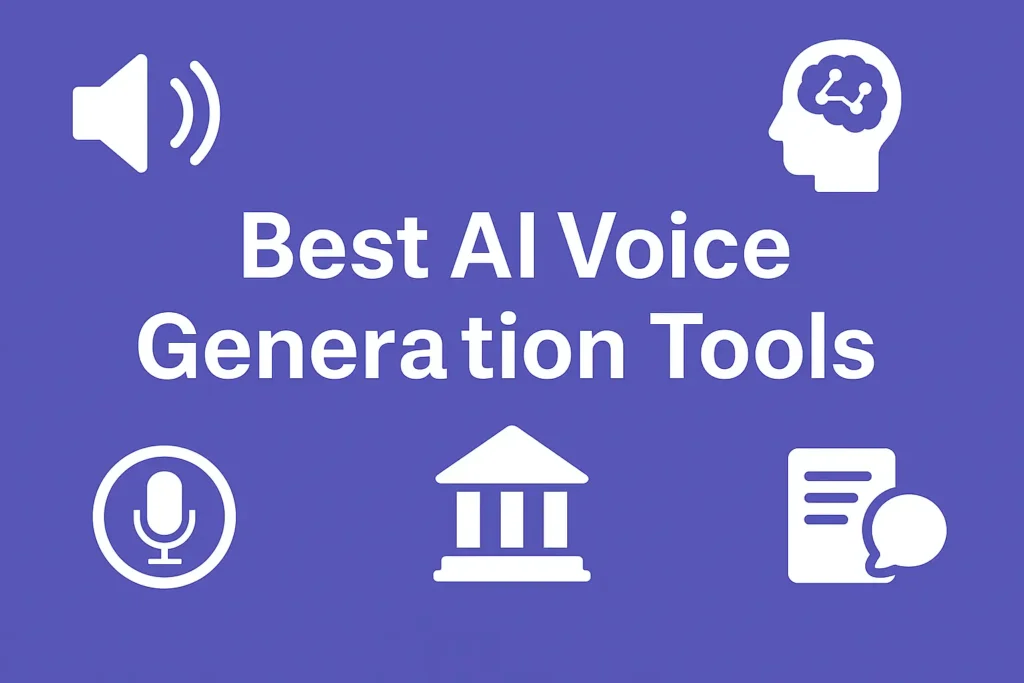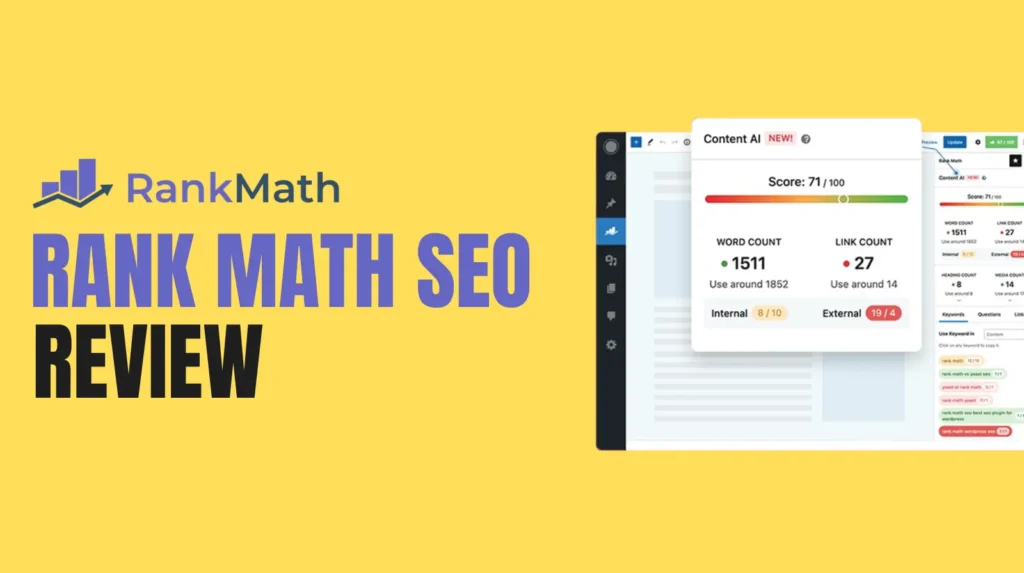In the dynamic world of digital content, the human voice has taken a remarkable leap into the future. AI voice generation is no longer the robotic, monotone sound of the past. Today, it’s a game-changing technology that allows creators and businesses to produce studio-quality voiceovers, dub content into dozens of languages, and create personalized audio experiences at an unprecedented scale.
This guide explores the best AI tools for voice generation and dubbing in 2025. Whether you’re a YouTuber, marketer, corporate trainer, or podcaster, you’ll find the perfect text-to-speech (TTS) solution to make your content speak to a global audience.
Quick Comparison: Top AI Voice Tools
| Tool | Best For | Standout Feature | Starting Price (Paid) |
| ElevenLabs | Hyper-realistic voiceovers | Emotional nuance & voice cloning | $5/month |
| Murf AI | Corporate & educational content | Voice changer & collaboration tools | $19/user/month |
| Lovo AI | Marketing & ads | 500+ voices with granular control | $24/user/month |
| Synthesia | AI video presentations | Integrated AI avatars & voice | $22/month |
| Descript | Podcasters & video editors | “Overdub” voice cloning & editing | $12/user/month |
| Play.ht | Bloggers & publishers | 900+ voices & WordPress plugin | $31.20/month |
| Resemble AI | Developers & creative projects | Real-time voice conversion API | Custom |
What Is AI Voice Generation?
AI voice generation is the use of artificial intelligence to convert written text into human-like speech. Modern text-to-speech (TTS) AI systems are built on deep learning models trained on vast datasets of human voices. This allows them to capture and replicate the subtle nuances of human speech, including different accents, tones, emotions, and languages.
The global text-to-speech market is projected to reach $12.5 billion by 2030, growing at a CAGR of 16.3%, highlighting its rapid adoption across industries.
Unlike the robotic voices of the past, today’s AI can express joy, empathy, urgency, or excitement, making them perfect for:
- YouTube videos and podcasts
- Audiobooks and e-learning modules
- Corporate training and marketing ads
- Video game characters and virtual assistants
- Language dubbing for film and series
Top 7 AI Voice Generation & Dubbing Tools of 2025
Let’s dive into the leading platforms in the AI voice and text-to-speech space. Each offers unique strengths tailored to different creative and professional needs.
1. ElevenLabs: Best for Hyper-Realistic & Emotional Speech
ElevenLabs is widely regarded as the market leader for producing the most realistic and emotionally resonant AI voices available today. Its advanced deep learning models generate speech that is often indistinguishable from a human voice actor, making it a favorite for high-quality creative projects.
Key Features:
- Speech Synthesis: Generates natural-sounding speech with remarkable control over intonation, pacing, and emotion.
- Voice Cloning: Creates a digital replica of your own voice from just a few minutes of audio.
- Multilingual Support: Supports 29 languages with high accuracy.
- Projects: A long-form content editor perfect for audiobooks and articles.
Our Expert Take: In our tests, ElevenLabs consistently produced the most convincing human-like voices, especially for storytelling. Its ability to convey subtle emotions sets it apart from competitors. The voice cloning feature is exceptionally powerful, though it must be used ethically.
- Best For: Audiobook narrators, filmmakers, podcasters, and anyone needing premium, emotionally rich voiceovers.
- Pricing: Free plan available. Paid plans start at $5/month.
2. Murf AI: Best for Corporate & Educational Content
Murf AI is a versatile and user-friendly text-to-speech platform designed for professionals. It offers a comprehensive suite of tools that go beyond simple voice generation, including a built-in video editor, collaboration features, and a large library of royalty-free music.
Key Features:
- Extensive Voice Library: Over 120 AI voices in 20+ languages.
- Voice Customization: Fine-tune pitch, speed, and emphasis to match your desired tone.
- Voice Changer: Record your own voice and transform it into a professional AI voice.
- Team Collaboration: A centralized workspace for teams to create and review voiceover projects.
Our Expert Take: Murf AI is the perfect all-in-one solution for corporate trainers, educators, and marketers. Its interface is incredibly intuitive, making it easy to create polished voiceovers for presentations, e-learning modules, and product demos without any technical expertise.
- Best For: Corporate trainers, educators, marketers, and product demonstrators.
- Pricing: Free plan available. Paid plans start at $19 per user/month (billed annually).
3. Lovo AI (Genny): Best for Marketing & Advertisements
Lovo AI, with its flagship product Genny, is a powerful AI voice generator that boasts a massive library of voices and robust customization options. It’s particularly popular for creating engaging audio for advertisements, social media content, and animations.
Key Features:
- 500+ AI Voices: A huge library of voices across 100+ languages and various emotional styles.
- Granular Control: Adjust emphasis at the word level for precise emotional delivery.
- AI Writer: An integrated scriptwriting assistant to help you craft compelling copy.
- Producer Mode: A powerful editor that allows for multi-layered audio and video production.
Our Expert Take: Lovo’s Genny stands out for its sheer variety of voices and granular editing controls. For marketers who need to A/B test different voice styles for ad campaigns or create localized content at scale, Lovo provides the flexibility and quality needed to succeed.
- Best For: Digital advertisers, animators, and content creators focused on voice branding.
- Pricing: Free plan available. Paid plans start at $24 per user/month (billed annually).
4. Synthesia: Best for AI Video Presentations with Voiceovers
Synthesia is primarily an AI video generation platform, but its text-to-speech capabilities are a core part of its offering. It allows you to create professional videos featuring realistic AI avatars that speak your text in over 120 languages, making it a go-to tool for corporate communication.
Key Features:
- AI Avatars: Choose from 140+ diverse AI avatars to narrate your script.
- 120+ Languages: Generate voiceovers and dub videos in a vast number of languages and accents.
- Custom Avatars & Voice Cloning: Create a digital twin of yourself for personalized video messages.
- Easy Video Editing: An intuitive, slide-based editor that requires no technical skills.
Our Expert Take: If your end goal is a video, Synthesia is the most efficient tool on this list. Instead of generating a voiceover and then adding it to a separate video editor, you can do it all in one place. It’s exceptionally useful for creating scalable training and onboarding materials.
- Best For: Corporate training, marketing videos, and explainer content.
- Pricing: Plans start at $22/month (billed annually).
5. Descript: Best for Podcasters and Audio/Video Editors
Descript is a revolutionary audio and video editing platform that works like a word document. Its standout AI feature, Overdub, lets you create a clone of your voice and then generate new words or correct mistakes simply by typing.
Key Features:
- Overdub Voice Cloning: Correct audio mistakes or add new content by typing, all in your own voice.
- Text-Based Editing: Edit audio and video recordings by editing the transcribed text.
- Studio Sound: Remove background noise and enhance speech quality with a single click.
- Multitrack Editing: A full-featured editor for podcasts and video production.
Our Expert Take: Descript is an absolute game-changer for podcasters and video creators. The ability to fix a misspoken word with Overdub without having to re-record an entire section is a massive time-saver. It’s less of a pure TTS generator and more of an AI-powered editing suite.
- Best For: Podcasters, video editors, journalists, and creators who frequently edit their own recordings.
- Pricing: Free plan available. Paid plans start at $12 per user/month (billed annually).
6. Play.ht: Best for Bloggers and Publishers
Play.ht offers a massive library of high-quality AI voices and is particularly well-suited for converting written content, like blog posts and articles, into audio. Its WordPress plugin makes it incredibly easy for publishers to add an audio version to their content.
Key Features:
- 900+ AI Voices: One of the largest voice libraries available, with support for over 140 languages.
- WordPress Plugin: Automatically create and embed audio versions of your blog posts.
- SSML Support: Use Speech Synthesis Markup Language for advanced control over pronunciation and pacing.
- Commercial Rights: All paid plans include commercial rights for your generated audio.
Our Expert Take: For bloggers and digital publishers looking to make their content more accessible and engaging, Play.ht is the ideal solution. The “set it and forget it” WordPress plugin can transform your entire archive into a podcast-like library, increasing time-on-page and reaching a new audience.
- Best For: Bloggers, digital publishers, and businesses wanting to convert written content into audio.
- Pricing: Plans start at $31.20/month (billed annually).
7. Resemble AI: Best for Developers and Creative Projects
Resemble AI is a flexible and powerful platform aimed at developers and creative teams who need custom AI voice solutions. It offers a suite of tools, including real-time voice conversion, emotion control, and an API for building custom integrations.
Key Features:
- Real-Time Voice Conversion: Change your voice into a target AI voice in real time.
- Emotion Control: Inject a range of emotions (happy, sad, angry) into your generated speech.
- Localization & Dubbing: Tools designed to dub content into other languages while preserving the original speaker’s style.
- Robust API: Integrate Resemble’s voice technology into apps, games, and other custom workflows.
Our Expert Take: Resemble AI is more of a developer-centric toolkit than a simple TTS editor. Its real-time capabilities are perfect for interactive applications like video games or virtual assistants. For businesses that need to build a truly unique and branded voice experience, Resemble’s API is the way to go.
- Best For: Game developers, interactive media creators, and companies needing custom API-driven voice solutions.
- Pricing: Custom pricing based on usage; contact for details.
AI Voice Cloning: The Ultimate Personalization
A key feature offered by tools like ElevenLabs, Descript, and Resemble AI is voice cloning. This process uses AI to create a digital replica of a specific human voice.
How it works: You provide a short audio sample (often just a few minutes) of the target voice. The AI analyzes its unique characteristics, pitch, tone, and cadence and builds a model that can then speak any text in that same voice.
Ethical Considerations: While incredibly powerful, voice cloning raises important ethical questions about consent, deepfakes, and misuse. Reputable platforms have strict policies requiring verification that you have the right to clone a voice. Always ensure you have explicit consent before cloning someone’s voice.
How to Choose the Best AI Voice Tool for You
With so many options, here’s a simple checklist to help you decide:
- Define Your Primary Use Case: What will you create most often?
- Creative Storytelling: Prioritize emotional realism (ElevenLabs).
- Corporate Training: Look for ease of use and video integration (Murf AI, Synthesia).
- Editing Your Own Voice: Choose a tool with advanced editing and cloning (Descript).
- Listen to Voice Samples: The “best” voice is subjective. Visit each platform’s website and listen to their voice samples. Does the quality meet your standards?
- Check Language and Accent Needs: Ensure the tool supports the languages and specific accents required to reach your target audience.
- Evaluate Customization Features: Do you need basic speed and pitch control, or do you require advanced, word-level emotional adjustments?
- Consider Your Budget and Scalability: Start with a free plan or trial to test the workflow. Choose a paid plan that offers the right amount of generation minutes or characters for your needs.
Final Thoughts
AI voice generation is no longer a futuristic concept, it’s a practical and powerful tool that is democratizing high-quality audio production. From creating accessible e-learning content to dubbing films for a global audience, text-to-speech AI is breaking down barriers and amplifying stories.
The tools listed here represent the best the industry has to offer in 2025. By choosing the right platform for your needs, you can save time, reduce costs, and create content that truly resonates with listeners around the world.








